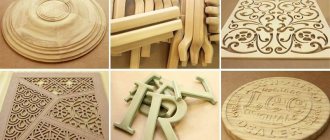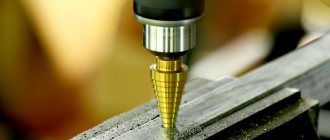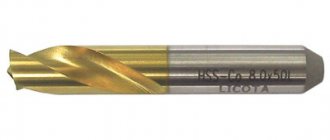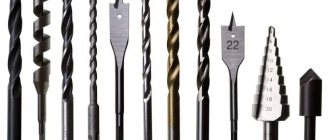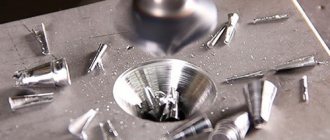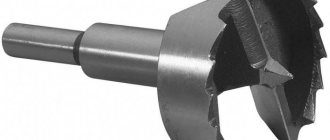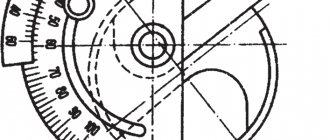A step drill is a universal tool for processing metal and plastic products. Its shape looks like a carrot or a Christmas tree. This is the difference from other metalworking devices: conical drills have a stepped design, which allows you to drill perfectly round holes of various diameters. Markings on the edges indicate the size of the section. Please note: the unit of measurement for this parameter can be either millimeters or inches.
When choosing a tool, pay attention to the type of material. Metal drills are subject to increased strength requirements, so their price is quite high.
Features and Benefits of Step Drills
The design of the product consists of two main parts:
- Working. The tip of the tool has a sharp shape. This eliminates the need for centering fixtures and allows you to work with the toughest materials. The finished hole does not require finishing with a needle file or grinder. The pitch of the steps depends on the type of tool and the size of the holes: up to 12 mm this figure is 1 mm, and over 12 mm - 2 mm. The minimum tool diameter is 4 mm, and the maximum is 38 mm. The standard step height is considered to be 5 mm, but drills with other sizes are available. Some manufacturers apply an abrasive coating to the working surface of step drills for metal - this increases the strength of the cutting edges and increases the sharpening interval of the tool.
- Drill shank. This part of the tool is fixed in the chuck. The shape depends on the type of drive mechanism. There are cylindrical, triangular and hexagonal shanks. The last two types prevent the tool from turning during operation. However, there is a downside: if the drill jams, there is a risk of injury to the operator.
Some users confuse step and cone drills. The difference lies in the shape of the working part. For conical tools, this is a series of step-by-step annular transitions and a longitudinal-spiral groove that has cutting edges. Thus, the size of the finished hole can only be adjusted using special stops on drilling machines.
Let's consider the main advantages of devices of this design:
- High accuracy. Using a classic tool does not allow you to drill a hole with smooth edges. This problem is especially acute when using drills with a diameter of more than 50 mm. The stepped design with smooth transitions allows you to obtain holes with perfectly smooth edges, regardless of the thickness of the material.
- Versatility. Having one drill replaces a whole set of tools. Simultaneously with drilling, chamfering is performed, which increases productivity.
- Ease of use. Marking the values on the body allows you to quickly select the desired diameter without using a caliper.
- Multifunctionality. With one drill you can process several types of surfaces: from wood or plastic to metal.
- Performance. Thanks to the use of high-quality materials, the drill can be used to process hard products without loss of quality.
Along with their advantages, the tools have a number of disadvantages. The high price and complex sharpening technology is a deterrent for some consumers. Professionals note that when drilling holes with a diameter of up to 15 mm, there is a slight decrease in accuracy.
Self-sharpening
Only the cutting edge (groove) is sharpened. It is prohibited to sharpen the transitions of step drills, as this leads to a change in the geometry of the working surface and the formation of burrs during operation. Improper sharpening leads to a decrease in the quality of the tool, often to complete unusability.
The long service life of conical drills requires periodic re-sharpening. At home, drills with a straight translational groove are the easiest to use. This is done manually using abrasive rods, diamond stones for knives or sandpaper.
Any home craftsman needs to know how to sharpen a step drill for metal with a spiral flute. The process requires the use of sharpening machines, on which the drill is directed so that the abrasive wheel passes exclusively in a spiral. For simultaneous smooth rotation, special devices are used; feeding the drill manually is highly not recommended.
Drills such as cone and step drills are very often confused with each other not only by craftsmen (we don’t take into account metalworking professionals), but also by salespeople in stores. I encountered the latter myself and was surprised by this fact. After all, there are differences, not only obvious visual ones, but also in characteristics and scope of application. Let's take a closer look at this topic.
Application area
Step drills are used to process various materials:
- ferrous and non-ferrous metals;
- wood;
- plywood;
- plastic;
- drywall.
The device works best when drilling sheet-shaped workpieces. In addition, drills are used as a means of preparing holes in large parts and structures. In this case, the drilling depth should not exceed 6 mm.
The original shape allows you to obtain high-quality holes without irregularities and burrs. When moving to the next step, automatic chamfering occurs.
Inexperienced craftsmen believe that cone drills are difficult to find use in everyday life. In fact, such devices are guaranteed to be useful in the household, especially during renovations. Step drills are an indispensable tool when installing electrical wiring. With their help, it is convenient to drill holes in the profile (0.5–0.7 mm thick) for pulling the corrugation. Using any other device will result in the metal being bitten, which will pose a risk of damage to the entire structure. The drill will also come in handy when installing new devices, when there is a need for an additional hole in the electrical panel, the thickness of which does not exceed 1 mm.
Drilling materials
Any natural or artificial, that is, man-made, material in certain cases needs holes. When we say “natural materials” and “certain applications,” we mean medical drills (dentistry, surgery, etc.), oil and gas drilling, and other similar options. Well, there is no point in talking about the need for technological, technical, decorative and other holes due to their obviousness.
The most well-known drilling materials in everyday life are:
- tree;
- metals;
- stone (brick, concrete).
There are also special drills for working with ceramic and glass products.
There are special drills for working with ceramic and glass products.
Types of step drills
Let's look at existing types. Conical drills for metal are distinguished according to the following parameters:
- Minimum and maximum diameter. There are tools for drilling holes up to 58 mm.
- Material of manufacture.
- Shank shape: round, triangular or hexagonal.
- Number and pitch of steps. Multi-stage drills offer the user greater freedom of action.
- Type of protective coating.
- The strength of the processed material.
Two-stage drills are classified as special tools. They are usually equipped with a countersink for a cylindrical or V-shaped screw head.
Number and shape of working grooves
An interesting feature of the device in question is the determination of the number of cutting edges. This parameter does not depend on the number of steps, since the cutting part is located on the grooves of the cone. In addition, they perform the function of removing chips during operation.
There are three types of grooves, which differ in shape:
- longitudinal;
- straight;
- spiral
Each design has its own advantages. For example, a straight edge lends itself much better to straightening and sharpening, while a spiral shape promotes softness and smoothness. This is the type of tool that is recommended for drilling thin-walled materials.
The quality of processing at high and low speeds depends on the number of grooves.
Eventually
Quite often, the reason why craftsmen refuse to buy stepped cone drills is precisely the high cost. After all, no one is spared the risk of purchasing a low-quality instrument or a counterfeit. That is why, in order to get a truly reliable device for drilling holes of different diameters, you should contact trusted suppliers and manufacturers. As a rule, the quality of products in this category is confirmed by appropriate certificates and special markings.
Marking
As an example, we use a cone drill Ø4-15/2 HRC 61±2. Explanation:
- 4 – minimum hole diameter;
- 15 – maximum size;
- /2 – step size change is 2 mm;
- HRC 61 – the material used is high-quality steel with a hardness of 61 on the Rockwell scale;
- ±2 – permissible error.
The grade of steel from which the device is made is applied to the surface of the tool. We recommend using products with HSS engraving. This means that the tool is made of high-speed steel, designed to operate at high speeds.
How to choose a cone drill
When considering models from various manufacturers, we recommend using the following tips:
- Read in detail the characteristics of the stepped gimlet. Some models are better suited to working with metal than other materials.
- Pay attention to the color of the product. A gray tint indicates that no finishing operations were carried out on the tool to increase its performance characteristics. Gray gimlets are very fragile - they are not recommended for use when processing products with high strength. A black tint indicates the presence of an oxide film formed by steam heat treatment. The light golden color indicates that the product has been hardened and then tempered. This procedure is carried out to relieve stress and reduce the brittleness of steel. The bright golden hue is characteristic of the highest quality gimlets with a titanium nitride finish. This element copes well with drilling durable materials and non-ferrous metals. Wear-resistant coating guarantees long service life.
Products made from steel alloyed with cobalt are placed in a separate category. The cost of such models is 3-4 times higher than analogues. In return, the user receives a high-quality product that is resistant to high temperatures, which allows parts to be processed at high speeds.
- Study the size and labeling of the product.
- The final choice is influenced by the reliability of the tool manufacturer. Proven brands will be discussed below.
- Possibility of sharpening. Such a tool will last much longer than a regular one. The service life also determines the high cost.
Popular manufacturers
There is a wide range of step drills available in the market in varying qualities. Let's look at the most famous manufacturers of drilling tools:
- Bosch. A German brand whose product quality has stood the test of time. The cost starts from 3 thousand rubles.
- Makita. The Japanese manufacturer of high-quality equipment offers consumers products in various price categories, starting from 1 thousand rubles.
- Haisser. Brand from China. Specializes in the production of hand and auxiliary tools. Thanks to special additives, drilling accessories can be used in the most difficult conditions.
Those who are looking for the optimal price-quality ratio should pay attention to the products of Zubr and Enkor. The products of these manufacturers have long been able to compete with leading brands.
The high cost often scares off potential buyers, despite the fact that a quality product can recoup all costs in the long run.
